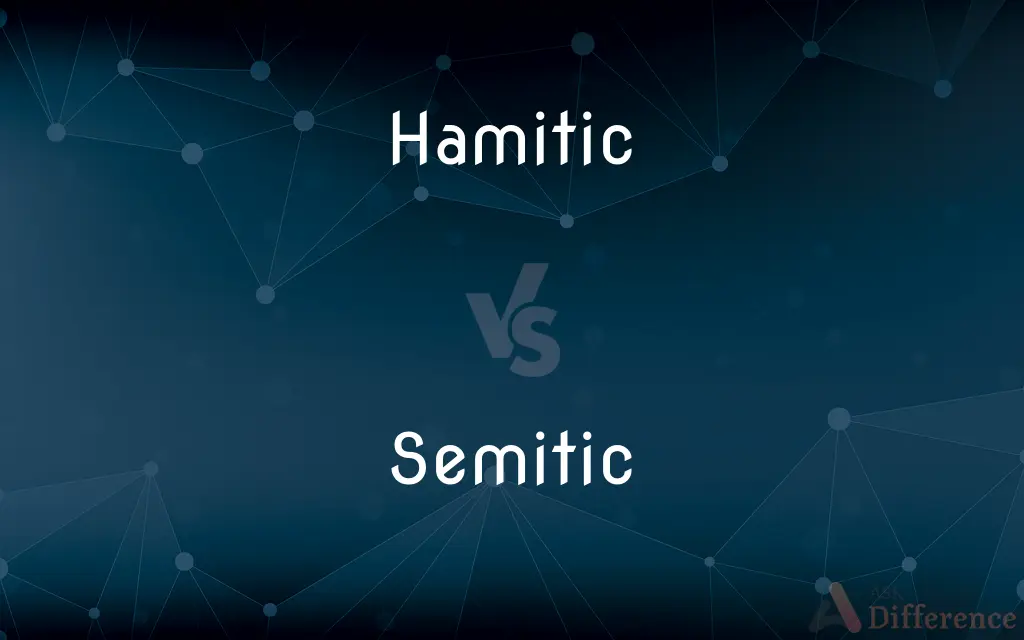Hamitic vs. Semitic — What's the Difference?
By Tayyaba Rehman & Maham Liaqat — Updated on April 20, 2024
Hamitic and Semitic are different group of Afroasiatic languages. Hamitic includes languages like Egyptian and Berber, focusing on North Africa, while Semitic encompasses languages like Arabic and Hebrew, prevalent in Middle East and Horn of Africa.

Difference Between Hamitic and Semitic
Table of Contents
ADVERTISEMENT
Key Differences
Hamitic languages, historically considered part of a distinct group within the Afroasiatic family, include various languages spoken across North Africa such as Berber and Ancient Egyptian. On the other hand, Semitic languages are a well-defined branch of Afroasiatic languages spoken by communities in the Middle East, including Arabic, Hebrew, and Amharic.
The term "Hamitic" is now largely obsolete in academic settings, as linguists have recognized that the languages previously categorized under this term do not form a coherent genetic group. Whereas, Semitic languages are clearly defined and include languages with a well-documented history of development and interaction.
Linguistically, Hamitic languages were thought to include both Cushitic and Egyptian languages, featuring certain grammatical and lexical characteristics. Conversely, Semitic languages are known for their triconsonantal root system, where words are formed around three-root consonants.
Cultural and historical impacts of Hamitic and Semitic languages differ significantly; Semitic languages have been influential in religious contexts due to their use in Jewish, Christian, and Islamic texts. Meanwhile, languages previously categorized as Hamitic, like Ancient Egyptian, have primarily historical significance with less contemporary religious or international impact.
In modern linguistic discourse, the focus has shifted towards understanding these languages' roles within the broader context of the Afroasiatic language family, moving away from outdated racial or cultural categorizations associated with the term "Hamitic." Semitic languages, however, continue to be studied extensively due to their ongoing cultural and religious relevance.
ADVERTISEMENT
Comparison Chart
Current Use of Term
Largely obsolete, not used in modern linguistics
Actively used in linguistic studies
Language Examples
Ancient Egyptian, Berber
Arabic, Hebrew, Amharic
Geographic Distribution
North Africa
Middle East, Horn of Africa
Linguistic Characteristics
Diverse, previously grouped by geographic and certain structural features
Triconsonantal root system, specific phonological and grammatical properties
Cultural Impact
Historically significant, less impact in contemporary global culture
Extensive impact in religious and cultural contexts worldwide
Compare with Definitions
Hamitic
Concerning the cultural or ethnographic studies of North African tribes and groups.
The study explored the social structures of Hamitic-speaking communities.
Semitic
Relating to a family of languages that includes Arabic, Hebrew, and Amharic.
Semitic languages are known for their rich literary traditions.
Hamitic
Relating to historical or archaeological contexts involving North African civilizations.
Hamitic artifacts are often found in ancient Egyptian archaeological sites.
Semitic
Pertaining to the peoples who speak these languages.
Semitic-speaking communities have historically spread across the Middle East.
Hamitic
Pertaining to the languages and peoples historically grouped as Hamitic, now considered part of the larger Afroasiatic family.
The Berber languages were once considered part of the Hamitic group.
Semitic
Concerning the linguistic characteristics unique to Semitic languages.
The triconsonantal root is a defining feature of Semitic linguistics.
Hamitic
Associated with theories now considered outdated and racial in nature.
The Hamitic hypothesis was used to justify European colonialism in Africa.
Semitic
Related to academic studies in Semitic studies, including theology, history, and philology.
He specialized in Semitic studies at the university.
Hamitic
Referring to linguistic studies before the reclassification under Afroasiatic.
Hamitic languages were once incorrectly believed to have a single origin.
Semitic
Involving the historical and cultural traditions of Semitic language speakers.
Semitic religions have played a crucial role in world history.
Hamitic
Of or relating to the Hamites or their languages or cultures. No longer in technical use.
Semitic
Of or relating to the Semites or their languages or cultures.
Hamitic
A presumed language family thought to include Egyptian and the Berber, Cushitic, and Chadic languages. No longer in technical use.
Semitic
Of, relating to, or constituting a branch of the Afro-Asiatic language family that includes Arabic, Hebrew, Amharic, and Aramaic.
Hamitic
Pertaining to Ham or his descendants.
Semitic
Jewish.
Hamitic
A group of languages in northen Africa related to Semitic
Semitic
The Semitic languages.
Semitic
Any of the Semitic languages.
Semitic
Of or pertaining to Shem or his descendants; belonging to that division of the Caucasian race which includes the Arabs, Jews, and related races.
Semitic
A major branch of the Afro-Asiatic language family
Semitic
Of or relating to the group of Semitic languages;
Semitic tongues have a complicated morphology
Common Curiosities
Why is the term 'Hamitic' considered obsolete?
The term is considered obsolete due to its association with outdated racial theories and the lack of a coherent linguistic or genetic basis for grouping these languages together.
What is the significance of the triconsonantal root system in Semitic languages?
This system, where words are formed around three consonants, is central to the morphology of Semitic languages and affects their syntax and lexical formation.
Are Semitic languages still widely spoken today?
Yes, Semitic languages like Arabic and Hebrew are widely spoken and hold significant religious, cultural, and political importance today.
Can you provide an example of a language previously considered Hamitic?
Berber languages, spoken in North Africa, were previously classified as Hamitic but are now categorized under the Afroasiatic language family.
What distinguishes Hamitic languages from Semitic languages?
Hamitic is an outdated term that was used to describe certain North African languages; Semitic languages, however, form a well-defined branch of the Afroasiatic language family with specific linguistic features.
What role do Semitic languages play in religious contexts?
Semitic languages like Hebrew and Arabic are crucial for Judaism and Islam, respectively, as they are languages of their sacred texts.
What is the historical importance of Semitic languages?
Historically, Semitic languages have been instrumental in the development of early writing systems and literary traditions in the Middle East.
How diverse are the Semitic languages?
Semitic languages exhibit significant diversity, with Eastern and Western branches including languages from Arabic and Hebrew to Ethiopian languages like Amharic and Tigrinya.
What led to the decline in the use of the term Hamitic?
The decline was due to shifts in linguistic theory and an effort to decolonize and de-racialize the language categorizations.
What are some common features of Semitic languages?
Common features include verb conjugations based on root consonants, specific consonant sounds, and a rich system of verbal and nominal forms.
How has the reclassification affected the study of Hamitic languages?
Reclassification has led to more accurate and culturally sensitive understanding of these languages within the broader context of Afroasiatic studies.
What are the archaeological implications of studying Semitic languages?
Archaeological studies involving Semitic languages help uncover the history and development of ancient civilizations in the Middle East.
Is there a modern replacement term for Hamitic languages?
Languages previously categorized as Hamitic are now more accurately described within the branches of the Afroasiatic language family, such as Berber or Cushitic.
Are there still communities that identify with the term Hamitic?
While some communities may historically associate with the term, it is not used in modern anthropological or linguistic contexts due to its problematic implications.
Can Semitic languages be learned easily by non-natives?
While challenging due to their unique features, many people successfully learn Semitic languages, especially Arabic and Hebrew, due to their global importance.
Share Your Discovery

Previous Comparison
Union vs. Intersection
Next Comparison
Roasting vs. CalcinationAuthor Spotlight
Written by
Tayyaba RehmanTayyaba Rehman is a distinguished writer, currently serving as a primary contributor to askdifference.com. As a researcher in semantics and etymology, Tayyaba's passion for the complexity of languages and their distinctions has found a perfect home on the platform. Tayyaba delves into the intricacies of language, distinguishing between commonly confused words and phrases, thereby providing clarity for readers worldwide.
Co-written by
Maham Liaqat















































